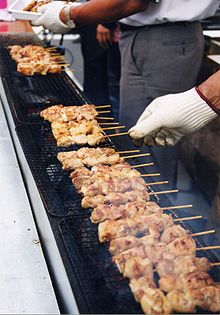Yakitori: Difference between revisions
No edit summary |
→Preparation: added 鶏肉 and yotsumi (四つ身) |
||
| Line 25: | Line 25: | ||
* ''rebā'' (レバー), liver |
* ''rebā'' (レバー), liver |
||
* ''sunagimo'' (砂肝) or zuri (ずり), chicken [[gizzard]] |
* ''sunagimo'' (砂肝) or zuri (ずり), chicken [[gizzard]] |
||
* ''toriniku'', all white meat on skewer |
* ''toriniku'' (鶏肉), all white meat on skewer |
||
* ''yotsumi'' (四つ身), pieces of chicken breast |
|||
==Common non-poultry dishes== |
==Common non-poultry dishes== |
||
Revision as of 23:31, 30 December 2014
This article has multiple issues. Please help improve it or discuss these issues on the talk page. (Learn how and when to remove these messages)
No issues specified. Please specify issues, or remove this template. |


Yakitori (焼き鳥, やきとり, ヤキトリ), grilled chicken, is commonly a Japanese type of skewered chicken. The term "yakitori" can also refer to skewered food in general. Kushiyaki (skewer grilled), is a formal term that encompasses both poultry and non-poultry items, skewered and grilled. Both yakitori and kushiyaki are used interchangeably in Japanese society.[citation needed]
Yakitori-ya are traditionally small restaurants or stands that grill yakitori to order over charcoal, to be consumed alongside alcoholic beverages (usually beer or shōchū) in the evening. These establishments are known for their informal and convivial atmospheres, and are popular gathering places particularly for young people and office workers on their way home. In some parts of Japan, large numbers of yakitori-ya can sometimes be found clustered together in one street or alley. Tokyo's Omoide-yokocho in Shinjuku is one particularly famous example. It is nearly similar to satay
Preparation
Yakitori is made with several bite-sized pieces of chicken meat, or chicken offal, mounted on a bamboo skewer and grilled, usually over binchōtan charcoal.
Diners ordering yakitori usually have a choice of having it cooked with salt (shio), or with tare sauce, which is generally made up of mirin, sake, soy sauce and sugar. The sauce is applied to the skewered meat which is grilled until delicately cooked.
- momo (もも), chicken thigh
- "negima" (ねぎま), chicken and spring onion
- tsukune (つくね), chicken meatballs
- (tori)kawa ((とり)かわ), chicken skin, grilled until crispy
- tebasaki (手羽先), chicken wing
- bonjiri (ぼんじり), chicken tail
- shiro (シロ), chicken small intestines
- nankotsu (なんこつ), chicken cartilage
- hāto / hatsu (ハート / ハツ) or kokoro (こころ), chicken heart
- rebā (レバー), liver
- sunagimo (砂肝) or zuri (ずり), chicken gizzard
- toriniku (鶏肉), all white meat on skewer
- yotsumi (四つ身), pieces of chicken breast
Common non-poultry dishes
These are not "yakitori" per se being something other than chicken. Both yakitori and these skewered dishes are more correctly referred to as "kushiyaki."
- ikada (筏) (lit. raft), Japanese scallion, with two skewers to prevent rotation
- gyūtan (牛タン), beef tongue, sliced thinly
- atsuage tōfu (厚揚げとうふ), thicker variety of deep-fried tofu
- enoki maki (エノキ巻き), enoki mushrooms wrapped in slices of pork
- pīman (ピーマン), green bellpepper
- asuparabēkon (アスパラベーコン), asparagus wrapped in bacon
- butabara (豚ばら), pork belly
- ninniku (にんにく), garlic
- shishito (獅子唐), Japanese pepper
See also
References
- Ono, Tadashi; Salat Harris (2011). The Japanese Grill: From Classic Yakitori to Steak, Seafood, and Vegetables. Ten Speed Press. ISBN 9781580087377



